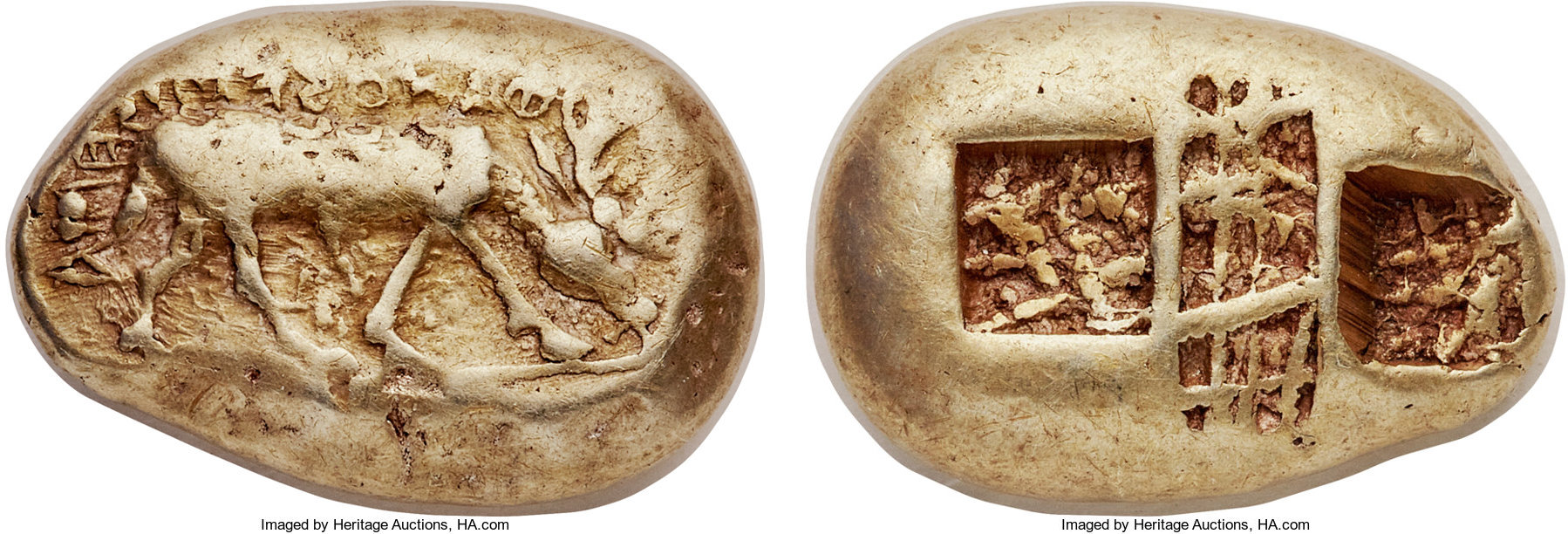S 1603 - Ephesus (Phanes), electrum, staters (625-600 BCE)
From SILVER
625 BCE - 600 BCE Electrum 12,944 kg
Description
| ObverseInscription or printing placed on the obverse.: | ΦΑΝΟΣ EMI ΣEIMA ("I am the badge of Phanes" or "I am the tomb of light") above, retrograde (Greek).Spotted stag walking right, head lowered |
| ReverseInscription or printing placed on the reverse.: | Two square incuse punches flanking rectangular incuse, all with linear cross-hatch patterns within |
Mint and issuing power
| MintIdentifies the place of manufacture or issue of a numismatic object.: | Ephesus | Ancient regionAncient region.: | Ionia | Modern countryModern country: Turkey | AuthorityIdentifies the issuing power. The authority can be "pretended" when the name or the portrait of X is on the coin but he/she was not the issuing power. It can also be "uncertain" when there is no mention of X on the coin but he/she was the issuing power according to the historical sources: |
Chronology
| FromIdentifies the initial date in a range assigned in a numismatic context. | 625 BCE | toIdentifies the final date in a range assigned in a numismatic context.. | 600 BCE | PeriodTime period of the numismatic object.: Archaic until 480 BC |
Physical description
| MetalThe physical material (usually metal) from which an object is made.: | Electrum http://nomisma.org/id/el | Median weightMedian of the weights of numismatic objects (in grams). in grams | 14.10 | DenominationTerm indicating the value of a numismatic object. Examples: tetradrachm, chalkous, denarius.: | stater |
StandardStandard.: | Milesian |
Image

S1603 Phanes staters.jpg [1]
References
| Die study referencePublication of the study: | Fischer-Bossert 2020c1Fischer-Bossert 2020c, p. 443-445, n° 1-4 | ||
| Coin series referenceReference to coin series study: | Sear II2Sear II, n° 3472 | ||
Obverse dies distribution
| FrequencyFrequency of specimen in distribution. ᵖ | Number of obversesNumber of obverse dies. ᵖ (o) | % (o) | Number of coinsNumber of coins. (n) | % (n) | Die nameName(s) of the die(s). |
| 1 | 2 | 50 | 2 | 11.76 | 3, 4 |
| 5 | 1 | 25 | 5 | 29.41 | 2 |
| 10 | 1 | 25 | 10 | 58.82 | 1 |
| Total | 4 of 4 | 100 | 17 of 17 | 99.99 |
Reverse dies distribution
no distribution is available
Quantification
| Number of obversesNumber of obverse dies. ᵖ (o) | 4 | Number of singletons (o1)The number of singleton coins. ᵖ | 2 |
| Number of reverse diesNumber of reverse dies. (r) | Number of coinsNumber of coins. (n) | 17 | |
| Coins per obverse dieNumber of coins per obverse die. (n/o) | 4.25 | Coins per reverse dieNumber of coins per reverse die. (n/r) | |
| Reverse per obverse ratioRatio of obverse dies divided by reverse dies. (r/o) | Percentage of singletons (o1)number of coins (n) divided by the number of singletons (o1) ᵖ | 50 % | |
| Original number of dies (O) (Carter 1983 formula)The estimation of the number of coins according to Carter 1983 ᵖ | 4.59 | Coins struck if 20,000 as average productivity per dieCoins made if the average productivity for obverses (according to Carter) is 20,000. ᵖ | 91,800 |
| Original number of dies (O) (Esty 2011 formula)The estimation of the number of coins according to the singleton formula in Esty 2011 ᵖ (O) | 5.23 | Survival rate if 20,000 as average productivity per dieSurvival rate if average productivity is 20,000. ᵖ | 0.00019 |
| Coverage (o = % of O) (Esty 1984 formula)Esty 1984 - coverage (% of O) ᵖ (o = % of O) | 88.24% | Die productivity if survival rate 1/2,000Average productivity if survival rate is 1/2,000. ᵖ | 7,407.41 |
| Weight of silver (in kg) if 20,000 coins per die (O = Carter formula)Carter 1983 * Median weight * 20000 (*10 if gold or electrum) ᵖ | 12,944 kg <br /> 12,944 kg | Die productivity if survival rate 1/5,000Average productivity if survival rate is 1/5,000. ᵖ | 18,518.52 |
Remarks